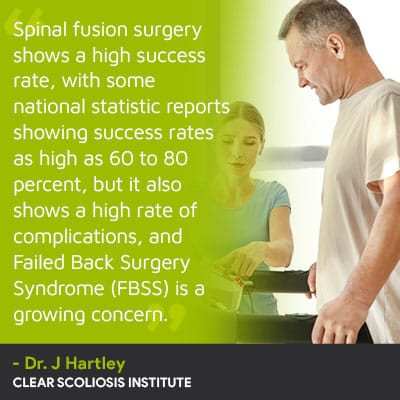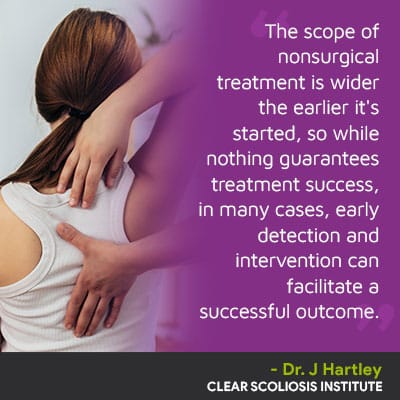
While scoliosis surgery was the dominant treatment option for many years, what you need to know is that many cases of scoliosis don't need surgical treatment. Scoliosis surgery is a type of spinal fusion, and while it can straighten a bent spine, it's an invasive procedure that can also alter the spine's long-term strength and function.
Scoliosis surgery success can be determined in different ways from curve reductions to spinal stability and quality of life. A successful outcome for scoliosis surgery means the spine is held in a straight and neutral alignment and progression isn't occurring.
While discussing the success rate of spinal fusion surgery, let's also address the procedure's associated risks.
There are two main responses to a diagnosis of scoliosis: traditional treatment and conservative treatment options.
Scoliosis causes the spine to bend unnaturally to the side and rotate, so it's a 3-dimensional spinal condition.
Traditional scoliosis treatment involves spinal fusion surgery, while conservative treatment is nonsurgical and combines the power of multiple scoliosis-specific treatment disciplines.
Conservative treatment is proactive and starts immediately following a scoliosis diagnosis, and traditional treatment is known for its recommendation to watch and wait while mild, and when/if a patient progresses into the severe classification, surgery is commonly recommended.
As a progressive condition, there is a risk to merely observing scoliosis, and as progression is triggered by growth, childhood scoliosis, in particular, needs to be addressed proactively.
The procedure of spinal fusion is associated with some risks, and there are also the long-term effects of living with a fused spine to consider.
Spinal fusion surgery involves determining which vertebrae in the curve are the most unnaturally tilted and fusing them into one solid bone so they can't become more tilted over time (progression), and in most cases, metal rods are attached to either side of the spine to hold it in place.
Hardware attached to the spine is permanent, and a spine that's fused is fused for life.
The goal of spinal fusion is to straighten the spine and stop progression.

What patients also need to understand is that if spinal fusion surgery is unsuccessful for any reason, the only recourse is more surgery, and successful outcomes become less likely with each subsequent procedure: Failed Back Surgery Syndrome.
It's estimated that 20-40 percent of spinal surgery doesn't improve the overall health of the spine.
Let's first determine what factors scoliosis surgery success is based on, as it can be measured in different ways.
Scoliosis severity is based on a measurement known as Cobb angle, and the higher the Cobb angle, the larger the unnatural spinal curve, the more rotation there is, and the more noticeable its effects are likely to be.
Scoliosis surgery success is determined by its ability to reduce the size of the scoliosis, so a reduction in a patient's Cobb angle is a main indicator of successful surgical treatment, and spinal fusion surgery is commonly recommended for patients with a Cobb angle of 45+ degrees.
In addition, increasing the spine's stability is another indicator of treatment success, particularly in older adult patients for whom fall prevention is a concern.
Ultimately, it's improvement to quality of life that's the best indicator of treatment success, and this is where the long-term effects of spinal fusion surgery need to be taken into account.
So what are the effects of spinal fusion, both short- and long-term?
All surgical procedures come with their share of risks, and spinal fusion is no exception; in fact, considering the important roles of the spine and the spinal cord within, spinal surgery can come with particularly serious potential risks, side effects, and complications.
Risks associated with the procedure itself include nerve damage, infection, excessive blood loss, an adverse reaction to hardware used, and any complication that occurs during the procedure may lengthen a patient's recovery time.
What I really want patients, and their families, to understand about spinal fusion are the long-term risks: the long-term effects of living with a fused spine.
When successful, spinal fusion can straighten a scoliotic spine and stop progression, but even with successful surgical outcomes, there can be negative long-term effects.
When it comes to spinal fusion, fusing the spine is contrary to its natural movement-based design, so a common effect is a loss in spinal flexibility and range of motion: an effect that can shape a patient's quality of life.
In addition, a fused spine is weaker and more vulnerable to injury, and the awareness of this can also have an emotional effect as some patients describe being fearful of trying new things and/or participating in once-loved activities.
Increased pain at the fusion site is also common as the spine is held in a fixed position; this type/level of spinal rigidity can be painful.
The muscles around the fusion site can also be affected as spinal fusion involves cutting through muscle to access the spine, and painful muscle spasms can develop in the days immediately following the procedure and can persist.
So while most spinal fusions are successful in terms of straightening the spine and stopping progression, its methodology can have its own range of effects, not all positive, and the reality is that many scoliosis patients respond as positively to less-invasive nonsurgical treatment.

The first goal of care is early detection; this means diagnosing patients while the scoliosis is still mild.
Mild scoliosis is simpler to treat because it involves smaller curves, and as a significant amount of progression hasn't yet occurred, condition effects are mild, and body compensations are easier to improve and/or reverse.
Diagnosing scoliosis while mild isn't always easy; the signs of mild scoliosis can be subtle and difficult to recognize, which is where awareness comes in.
As such a prevalent spinal condition, particularly among children, scoliosis awareness can help with early detection by educating parents on the early signs to watch for, along with common risk factors.
The earliest signs of scoliosis in children involve postural changes, and in adults, back and nerve pain is the most common symptom.
Once a scoliosis diagnosis is reached, the most important decision is how to treat it because the choice will shape the spine's long-term health and function.
Here at the CLEAR Scoliosis Institute, nonsurgical treatment options are integrative, combining the power of what scoliosis-specific chiropractic care, physical therapy, and corrective bracing have to offer.
And when diagnosed early and treated proactively, the scope of nonsurgical treatment is wider, and as it works towards preserving as much of the spine's natural strength and function as possible, it doesn't come with the same potential side effects as surgical treatment.
Scoliosis surgery success is based on its ability to reduce a patient's curve size for a straighter spine and stop progression.
There are different types of spinal fusion surgery, some considered to be less invasive, but most involve fusing the curve's most-tilted vertebrae into one solid bone and stabilizing the spine's position with metal rods attached to the spine with pedicle screws.
While spinal fusion can indeed straighten the spine and stop the curve from increasing in size over time, it can also have some negative effects that patients need to be aware of; patients also need to be aware that there is more than one treatment option for scoliosis, and not all lead to surgery.
Conservative nonsurgical treatment is evidence-based and patient-centered, so each treatment plan is customized around key patient/condition variables.
Nonsurgical treatment focuses on strengthening the spine and restoring its natural curves, while spinal fusion surgery focuses on stopping progression.
In addition, the main reason many patients opt for surgical treatment is cosmetic; they think surgery is the best way to restore their posture and body appearance, but the reality is that spinal fusion only addresses the spine, and not the different ways scoliosis can affect the body.
So for patients wanting a complete approach to scoliosis treatment, one that's proactive and doesn't just address how scoliosis affects the spine, but also its surroundings and the entire body, the CLEAR approach has proven results.

CLEAR provides a unique and innovative way of understanding scoliosis. Sign up to receive facts and information you won’t find anywhere else.
